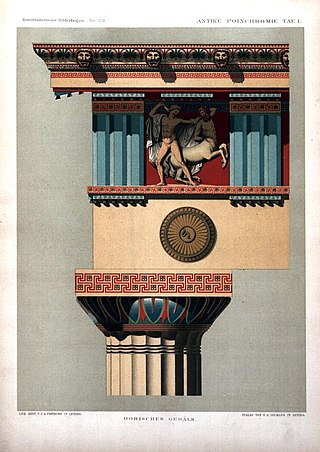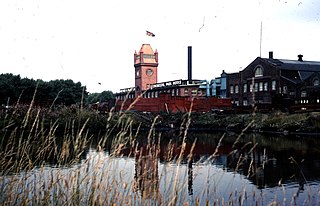Related Research Articles

In metalworking and jewelry making, casting is a process in which a liquid metal is delivered into a mold that contains a negative impression of the intended shape. The metal is poured into the mold through a hollow channel called a sprue. The metal and mold are then cooled, and the metal part is extracted. Casting is most often used for making complex shapes that would be difficult or uneconomical to make by other methods.

A goldsmith is a metalworker who specializes in working with gold and other precious metals. Nowadays they mainly specialize in jewelry-making but historically, goldsmiths have also made silverware, platters, goblets, decorative and serviceable utensils, and ceremonial or religious items.
A moldmaker or molder is a skilled tradesperson who fabricates molds for use in casting metal products.

Guilloché is a decorative technique in which a very precise, intricate and repetitive pattern is mechanically engraved into an underlying material via engine turning, which uses a machine of the same name, also called a rose engine lathe. This mechanical technique improved on more time-consuming designs achieved by hand and allowed for greater delicacy, precision, and closeness of line, as well as greater speed.

Polychrome is the "practice of decorating architectural elements, sculpture, etc., in a variety of colors." The term is used to refer to certain styles of architecture, pottery or sculpture in multiple colors.

Woodturning is the craft of using a wood lathe with hand-held tools to cut a shape that is symmetrical around the axis of rotation. Like the potter's wheel, the wood lathe is a mechanism that can generate a variety of forms. The operator is known as a turner, and the skills needed to use the tools were traditionally known as turnery. In pre-industrial England, these skills were sufficiently difficult to be known as 'the mysteries of the turners guild. The skills to use the tools by hand, without a fixed point of contact with the wood, distinguish woodturning and the wood lathe from the machinist's lathe, or metal-working lathe.

Sand casting, also known as sand molded casting, is a metal casting process characterized by using sand as the mold material. The term "sand casting" can also refer to an object produced via the sand casting process. Sand castings are produced in specialized factories called foundries. Over 60% of all metal castings are produced via sand casting process.

Wall boxes are a type of post box or letter box found in many countries including France, the United Kingdom, the Commonwealth of Nations, Crown dependencies and Ireland. They differ from pillar boxes in that, instead of being a free-standing structure, they are generally set into a wall or supported on a free-standing pole, girder or other stable structure.

A foundry is a factory that produces metal castings. Metals are cast into shapes by melting them into a liquid, pouring the metal into a mold, and removing the mold material after the metal has solidified as it cools. The most common metals processed are aluminum and cast iron. However, other metals, such as bronze, brass, steel, magnesium, and zinc, are also used to produce castings in foundries. In this process, parts of desired shapes and sizes can be formed.
Bellfounding is the casting and tuning of large bronze bells in a foundry for use such as in churches, clock towers and public buildings, either to signify the time or an event, or as a musical carillon or chime. Large bells are made by casting bell metal in moulds designed for their intended musical pitches. Further fine tuning is then performed using a lathe to shave metal from the bell to produce a distinctive bell tone by sounding the correct musical harmonics.
Haigh Foundry was an ironworks and foundry in Haigh, Lancashire, which was notable for the manufacture of early steam locomotives.

In metallurgy, a ladle is a bucket-shaped container or vessel used to transport and pour out molten metals. Ladles are often used in foundries and range in size from small hand carried vessels that resemble a kitchen ladle and hold 20 kilograms (44 lb) to large steelmill ladles that hold up to 300 tonnes. Many non-ferrous foundries also use ceramic crucibles for transporting and pouring molten metal and will also refer to these as ladles.

In casting, a pattern is a replica of the object to be cast, used to prepare the cavity into which molten material will be poured during the casting process.

Cast-iron architecture is the use of cast iron in buildings and objects, ranging from bridges and markets to warehouses, balconies and fences. Refinements developed during the Industrial Revolution in the late 18th century made cast iron relatively cheap and suitable for a range of uses, and by the mid-19th century it was common as a structural material, and particularly for elaborately patterned architectural elements such as fences and balconies, until it fell out of fashion after 1900 as a decorative material, and was replaced by modern steel and concrete for structural purposes.

Mather & Platt is the name of several large engineering firms in Europe, South Africa and Asia that are subsidiaries of Wilo SE, Germany or were founded by former employees. The original company was founded in the Newton Heath area of Manchester, England, where it was a major employer. That firm continues as a food processing and packaging business, trading as M & P Engineering in Trafford Park, Manchester.

The American Foundry Society (AFS) is a professional, technical and trade association for foundries and the broader metal casting industry. The society promotes the interests of foundries to policymakers, provides training for foundry workers, and supports research and technological advancements in foundry science and manufacturing.

Casting is a manufacturing process in which a liquid material is usually poured into a mold, which contains a hollow cavity of the desired shape, and then allowed to solidify. The solidified part is also known as a casting, which is ejected or broken out of the mold to complete the process. Casting materials are usually metals or various time setting materials that cure after mixing two or more components together; examples are epoxy, concrete, plaster and clay. Casting is most often used for making complex shapes that would be otherwise difficult or uneconomical to make by other methods. Heavy equipment like machine tool beds, ships' propellers, etc. can be cast easily in the required size, rather than fabricating by joining several small pieces. Casting is a 7,000-year-old process. The oldest surviving casting is a copper frog from 3200 BC.
Foundry Products Operations was a subsidiary operation of the Cincinnati Milling Machine Company (CMM), a company which no longer exists. Some parts of the company evolved into the present Milacron, Inc. and Cincinnati Machine. CMM relied heavily on castings for the manufacturing of its machine tool products. The castings were produced at Cincinnati foundries owned by CMM and at foundries independent of CMM, between 1907 and 1988.
The Federated Moulders' (Metals) Union of Australia (FMMUA) was an Australian trade union which existed between 1899 and 1983. It represented moulders – skilled tradesmen who fabricated the moulds for casting metal products in foundries. In spite of only organising within a single skilled occupation, which kept total membership low, the vital position of moulders in major industries such as mining, manufacturing and the railways, ensured that the union remained industrially powerful with a reputation for being highly militant.
Edward Cockey (1781–1860) was an industrial entrepreneur in Frome, Somerset, England, descended from a local family of metalworkers.
References
- ↑ "The iron founder" supplement. A complete illustrated exposition of the art of casting in iron. Also, the founding of statues; the art of taking casts, pattern modelling; useful formulas and tables (1893)
- ↑ Dobraszczyk, P. (2014) Iron, Ornament and Architecture in Victorian Britain: Myth and Modernity ..., Ashgate Publishing, Ltd., pp. 29-32
- ↑ Holtzapffel, C. (1843) Turning and Mechanical Manipulation:..., Holtzapffel & Co., London, p. 327
- ↑ Edward Hazen, Reuben S. Gilbert, Abraham John Mason, John Ludlow Morton, Stephen H. Gimber, Raphael Hoyle, Charles Burton Uriah Hunt, 1837